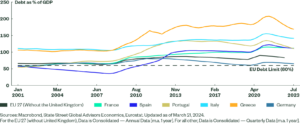U.S. and global market participants will be keeping a close eye on five key developments in 2023 that could herald changes in market sentiment – positively or negatively – depending on the flow of economic data.
(1) When does the Federal Reserve (Fed) reach its peak rate for this cycle? Based on Fed guidance, a peak federal funds rate between 4.75% and 5.50% seems likely to be attained at the March 22 Federal Open Market Committee (FOMC) meeting, although a delay is possible. For markets though, it is all about the journey and not the destination. A peak rate of a quarter of a percentage point one way or the other makes little difference to the economy. Yet, once the Fed acknowledges that it has reached a sufficiently restrictive rate at which it can pause and take stock, the central bank narrative will likely change from “vigilant inflation hawk” back to being “data dependent.” And, the data may well be favorable for reduced inflation, so that market participants are likely to breathe a sigh of relief.
What is in play? Obviously, rates and equities, but FX, too. The major central banks are not on the same page, especially now when it comes to both the timing at which they will hit their peak rates and what the peak rates might be.
(2) Will the U.S. economy enter a recession in 2023? The inverted yield curve argues for a recession. Yet, it is not so clear. Consumption is two-thirds of GDP, and growth in consumption depends primarily on jobs, not interest rates. Consumption falters quickly and seriously when job losses are piling up across the economy. That is not the case now. Job openings are abundant in hospitality and tourism, while more cutbacks might be coming in Silicon Valley and on Wall Street. On net, jobs are still growing, and the widely forecasted recession of 2023 may be very mild or not occur at all.
Watch the weekly new unemployment insurance claims data that comes out every Thursday morning at 8:30am Eastern time. The U.S. has been running below 225,000 new claims a week, adjusted seasonally. If this number were to climb over 250,000, concerns will mount. If this number climbs rapidly toward 300,000 or more, a recession could arise. Not a forecast, just data to monitor closely.
(3) How fast will inflation decline? One needs to look to the causes of the inflation surge and make sure they are reversed. If the causes have been reversed, then inflation could recede, albeit with a significant time lag and possibly not return all the way to previous levels. The Fed’s target is 2%.
All five major causes of the inflation of 2022 – pandemic-related real GDP disruption, supply chain challenges, fiscal stimulus, quantitative easing (QE) by the Fed, and low interest rates – have all been reversed. Headline inflation peaked in June 2022 and is already headed downward. Core inflation may follow more slowly in the spring and summer as 2023 progresses because it will take time for the damage already done to the housing market to filter through to the calculation of shelter in the core inflation index, as well as for other service sectors to absorb the higher costs associated with the headline inflation surge. Don’t worry about hourly wages, as they follow inflation with a lag and do not cause inflation. Wage growth is part of the process of headline inflation seeping into core inflation over time. Once headline inflation drops below core inflation, possibly in Q2/2023, then the reduction in core inflation will likely pick up speed.
(4) Government funding and debt ceiling impasse — might be coming to the U.S. in the second half of 2023. This will be a nail-biter as the U.S. Congress always goes down to the wire (September 30 for funding the government; possibly August for the debt ceiling, depending on the pace of tax revenues). Often the U.S. Congress kicks the can down the road for a week, maybe defer it twice or more, and finally either cuts a deal or forces a partial federal government shutdown impacting about 800,000 or so federal workers. The furloughed workers lose their paychecks while the government is shut down, but Congress always authorizes full back pay once the shutdown is over. Get out your August 2011 playbook, but this episode could last longer than in 2011 if a deal is not reached and it goes to a shutdown. In the leadup to a deadline, if a shutdown looks increasingly likely, then money market funds will stop buying T-Bills that mature in the period ranging from a possible shutdown to a few months further out.
(5) A China recovery in 2023 is likely in the cards once it overcomes a resurgence in Covid cases amid its bumpy exit from its zero-tolerance policies. Watch travel during the Lunar New Year week – It is goodbye to the Tiger and hello to the Year of the Rabbit, embodying elegance, peace, and a bit of luck. China’s real GDP growth rate could rebound to 5% or 6% later in 2023, then settle back in 2024 and beyond to a 3% to 4% trend primarily constrained by long-term demographic headwinds.
Watch the Chinese yuan and industrial metals. Personal consumption in China plummeted during the Covid-Zero years. When consumption and travel resume full speed, imports will rise, which could create more currency volatility. And, an economic rebound in China is a positive influence for commodity prices, especially global crude oil and industrial metals such as copper and aluminum.
—
Originally Posted January 18, 2023 – Five Reasons Market Sentiment Might Change in 2023
All examples in this report are hypothetical interpretations of situations and are used for explanation purposes only. The views in this report reflect solely those of the author and not necessarily those of CME Group or its affiliated institutions. This report and the information herein should not be considered investment advice or the results of actual market experience.
Disclosure: Interactive Brokers
Information posted on IBKR Campus that is provided by third-parties does NOT constitute a recommendation that you should contract for the services of that third party. Third-party participants who contribute to IBKR Campus are independent of Interactive Brokers and Interactive Brokers does not make any representations or warranties concerning the services offered, their past or future performance, or the accuracy of the information provided by the third party. Past performance is no guarantee of future results.
This material is from CME Group and is being posted with its permission. The views expressed in this material are solely those of the author and/or CME Group and Interactive Brokers is not endorsing or recommending any investment or trading discussed in the material. This material is not and should not be construed as an offer to buy or sell any security. It should not be construed as research or investment advice or a recommendation to buy, sell or hold any security or commodity. This material does not and is not intended to take into account the particular financial conditions, investment objectives or requirements of individual customers. Before acting on this material, you should consider whether it is suitable for your particular circumstances and, as necessary, seek professional advice.
Disclosure: Forex
There is a substantial risk of loss in foreign exchange trading. The settlement date of foreign exchange trades can vary due to time zone differences and bank holidays. When trading across foreign exchange markets, this may necessitate borrowing funds to settle foreign exchange trades. The interest rate on borrowed funds must be considered when computing the cost of trades across multiple markets.












![[Gamma] Scalping Please [Gamma] Scalping Please](https://ibkrcampus.com/wp-content/smush-webp/2024/04/tir-featured-8-700x394.jpg.webp)
![[Gamma] Scalping Please [Gamma] Scalping Please](https://ibkrcampus.com/wp-content/uploads/2024/04/tir-featured-8-700x394.jpg)










![[Gamma] Scalping Please [Gamma] Scalping Please](https://ibkrcampus.com/wp-content/smush-webp/2024/04/tir-featured-8-300x169.jpg.webp)
![[Gamma] Scalping Please [Gamma] Scalping Please](https://ibkrcampus.com/wp-content/uploads/2024/04/tir-featured-8-300x169.jpg)